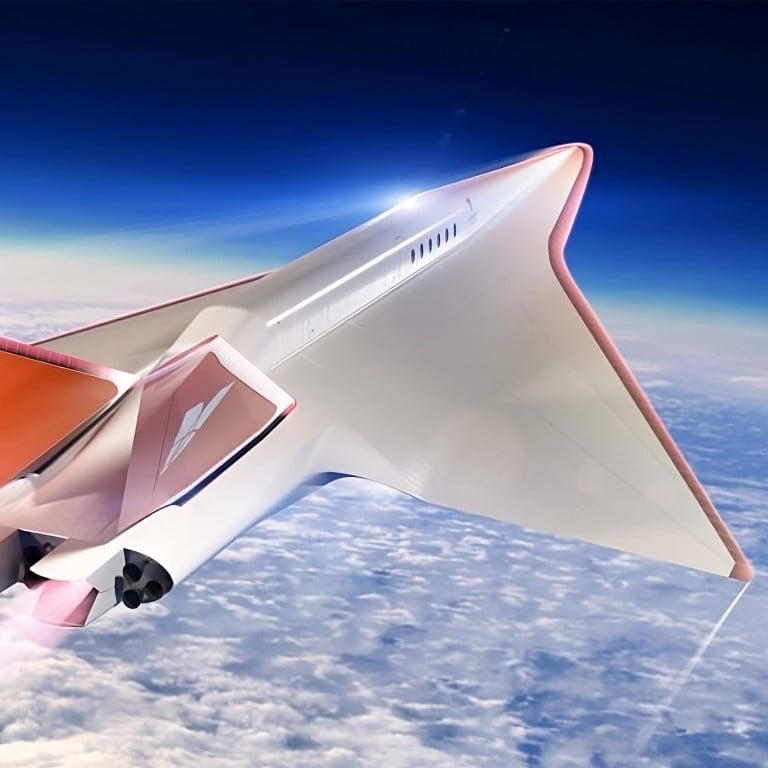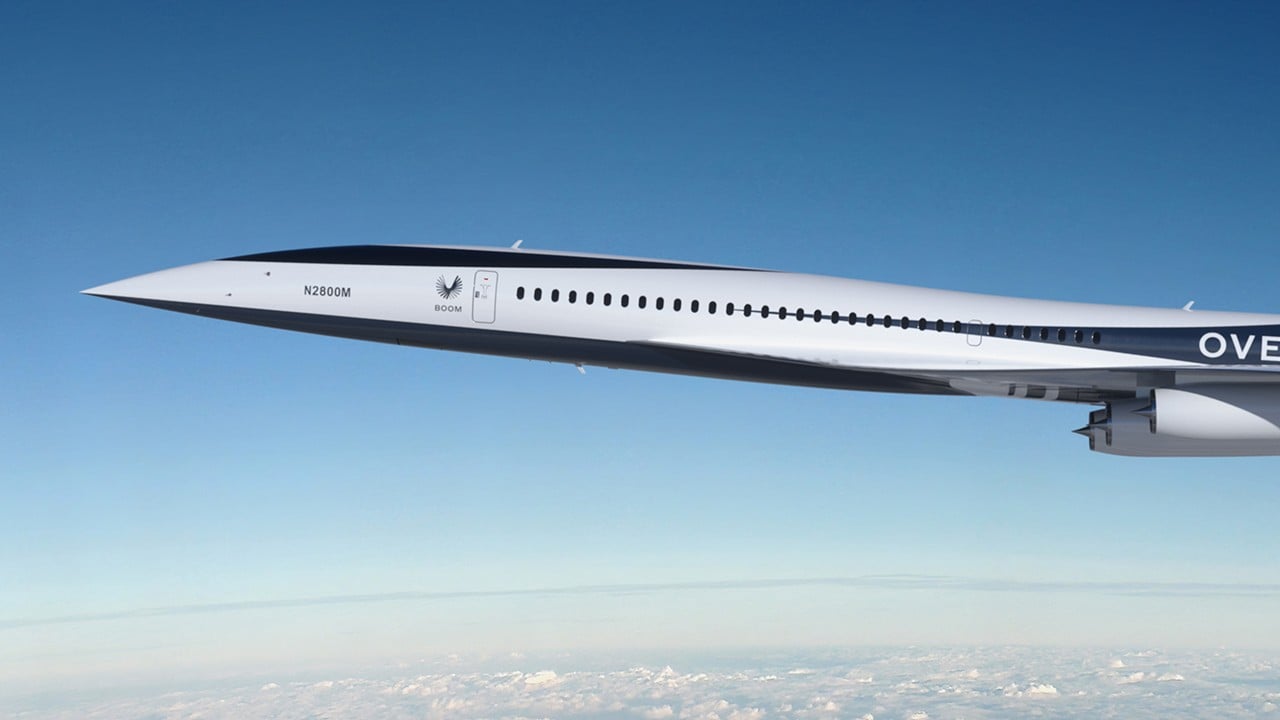
Tokyo to New York in 1 hour? Hypersonic ‘Stargazer’ jet aims to best Concorde
- Venus Aerospace’s planned jet is being designed to fly at around 8,000km/h with rocket engines to climb to an altitude of 52,000 metres
- The husband-wife team behind the project are aiming for tickets to cost the same as the current price of first class – but there’s no guarantees
The last time humans witnessed supersonic travel was the legendary Concorde, which operated from 1973 to 2003. Equipped with four powerful engines, the super-speedy plane could journey from New York to London in less than four hours – a tremendous feat for the era.
However, some ambitious engineers are hoping to fly even faster, including European start-up Destinus, Georgia-based Hermeus, and Texas-born Venus Aerospace – all of which are developing hypersonic planes.
Venus, in particular, was only founded in 2020 but has big plans for Mach 9 travel. Company co-founders Chief Executive Officer Sassie Duggleby and Chief Technology Officer Andrew Duggleby were interviewed at the Paris Airshow in June for this article to learn more about their planned jet, dubbed “Stargazer”.
Flying at least five times the speed of sound, Stargazer is designed to bullet from San Francisco to Tokyo in just one hour – 11 times faster than today’s flight time.
According to Venus, the jet is being developed to fly at Mach 9, or nine times the speed of sound. That equates to about 8,000km/h (5,000mph).
By comparison, the Concorde flew at about Mach 2, Overture is being built for Mach 1.7, and Hermus and Destinus are designing their hypersonic planes for Mach 5.
Andrew said that one-hour global transport would be made possible thanks to a combination of jet and rocket engines.
He explained that Stargazer would take off using traditional jet engines. Once it is away from city centres, it would switch to rocket engines to climb to 170,000 feet (52,000 metres) and reach hypersonic speeds.
The incredible altitude is more than four times as high as traditional jetliners fly and will give passengers a view of the Earth’s curve and the darkness of space.
Most passenger airlines fly around 40,000 feet, meaning Stargazer’s planned cruising altitude is about 130,000 feet higher – though still not high enough to touch space.

“We were on deployment in Japan when we were looking out at Tokyo Bay one afternoon and Andrew turned to me and said there’s this new rocket engine coming down the pipeline,” Sassie said. “And, he said if it’s ever proven, then we can put it on a plane and be home in an hour.”
But, reaching this ambitious goal will be a monumental task and require Venus to build upon already proven technologies, as well as develop new ones, like the “world’s first liquid-propellant rotating detonation rocket engine”.
Andrew explained that today’s rocket engines burn subsonically, which would not be enough power for Stargazer.
But supersonic combustion would produce enough thrust for hypersonic flight. This led Venus to build the RDRE.
According to Andrew, the RDRE generates more temperature and pressure compared to traditional rocket engines because it burns faster, effectively producing more thrust while using less fuel.
Rocket engines, in general, are also preferred because they offer much better performance at higher altitudes compared to jet engines because they do not feed on outside oxygen, which is much thinner at 170,000 feet.
Andrew said that Stargazer would carry a “sort of liquid air” to power the rocket engines.
In October 2022, Venus became the first company in the world to engineer “room temperature storable liquid fuels” to operate in an RDRE: “We now have both the technical knowledge and engineering to fully advance into next steps of development and flight testing,” Andrew said at the time.
Sassie compared the concept to a scene in the film Top Gun: Maverick where Tom Cruise’s character Pete “Maverick” Mitchell flies a military test plane to Mach 10 using a jet engine.
The fictional jet is the SR-72 “Darkstar”, which doesn’t actually exist but is an unmanned hypersonic plane concept proposed by Lockheed Martin as a successor to the SR-71 “Blackbird”.
She said the SR-72 started to “melt” due to the immense 1,100 degrees Celsius (2,000 degrees Fahrenheit) heat generated from flying at hypersonic speeds – especially at the lower altitude required for the jet engine.

Sassie described Maverick’s fictional actions as “flying through the soup of the atmosphere”.
Venus, however, plans to swap the jet engine out with a rocket engine – meaning it can fly above the heat and bring the aircraft’s skin temperature down to around 430 degrees (800 degrees Fahrenheit), Andrew said.
This would also effectively allow Venus to use traditional materials that are lightweight, like titanium – no need for a robust fuselage with heat shields or other heavy protections.
Moreover, Venus bringing its own oxygen will solve the problem of passengers needing air at high altitudes: especially in the case of depressurisation.
Andrew also addressed the concern of micrometeorites in the atmosphere, but pointed to Blue Origin and Virgin Galactic as examples of “public engineering that show how they would handle it”.
Venus recently announced a partnership with Airbus Ventures – an arm of the European planemaker – to further develop its hypersonic engine.
Sassie said in a press release that Venus’ RDRE “demonstrates a double-digit percentage increase in efficiency over standard regular engines, making the hypersonic economy possible”.
Other innovations include Stargazer’s wave-rider design, which is a “highly efficient boost-glide mode of flight” and essentially helps the jet ride its own shock waves created by hypersonic speeds.
We’re looking for this to be for everyday people
Competing planemaker Destinus is using the same design on its “Destinus S” and “Destinus L” passenger planes, both of which are also at least a decade away.
As far as passenger comfort, Andrew said that the Stargazer cabin will be all business class and that the “liquid air” on board will help cool the 12-passenger cabin.
Andrew also explained that the climb to 170,000 feet will be smooth to ensure passengers do not experience g-force: “We’re looking for this to be for everyday people,” he said.
However, Sassie explained plane tickets will be impossible to keep cheap, saying studies show the fares for hypersonic travel will be anywhere between two and five times the cost of a first-class ticket.

A typical Concorde ticket cost US$6,000 one-way in the late 1990s. The most-frequent Concorde flier is Fred Finn, who flew on the supersonic plane 718 times and spent over US$2.5 million (about US$4.4 million today) on seats until the jet’s retirement in 2003.
Sassie noted that the data point is based on current market surveys, and Venus is aiming for the current price of first class.
Venus research revealed business travellers are willing to pay more than a regular first-class ticket price if they can cut long-haul flying to only one hour. Current first-class airfares on carriers like Emirates and Singapore Airlines are in the tens of thousands of dollars.
While the company is confident demand is there, Stargazer is not expected to hit the market until at least the 2030s, and regulations surrounding hypersonic travel are still basically non-existent.
There’s an incredible amount of hurdles we have to get through … We’re just taking it one step at a time
Things like airport infrastructure and air traffic control flows have not been written into law and will require a lot of research and testing.
But Venus recently got a win when it lobbied Congress to add language into the FAA’s Reauthorisation Act of 2023 to “provide a clear framework” for hypersonic testing and development.
The FAA Reauthorisation Act of 2023 will amend the prior act of 2018 with improvements to things like safety and technology, as well as current guidance and policy.
This is a major win for hypersonic start-ups like Venus and Hermeus, especially since both have complained of the lack of long-distance “corridors” that allow for supersonic testing over land.
Hermeus is a US start-up tapped by the US Department of Defence to build a hypersonic Air Force One. It competes with Venus.
Despite the win in Congress, Venus acknowledged the development of hypersonic travel still has a long way to go.
Venus said it is aiming to introduce Stargazer in the 2030s, which is on track with Destinus’ timeline for its “Destinus S” hypersonic plane.
“There’s an incredible amount of hurdles we have to get through,” Sassie said. “We’re just taking it one step at a time and the team continues to make incredible progress, and we’re hitting the milestones we want to hit.”
Andrew explained that Venus is continuing to test the engine in partnership with Airbus Ventures, and it will soon be put onto a drone for further development.


